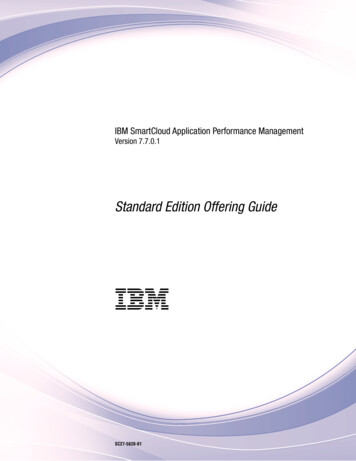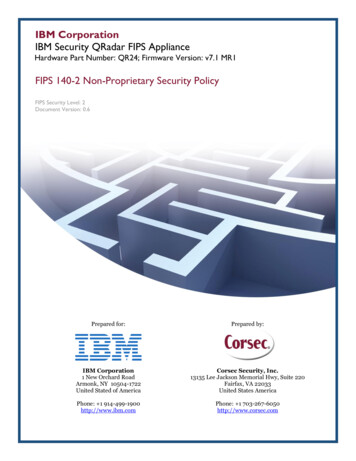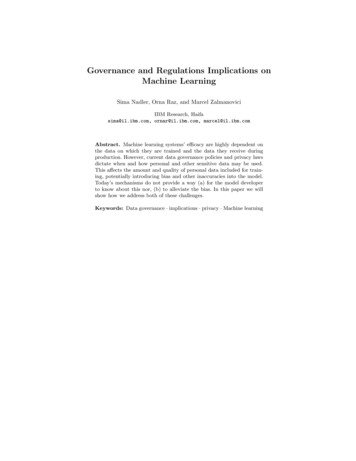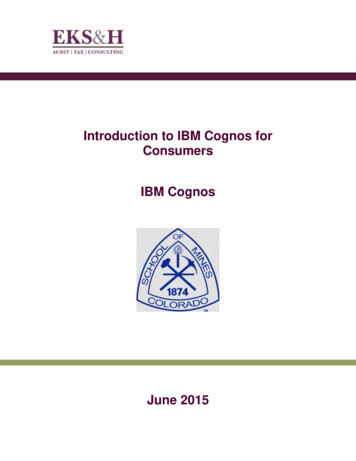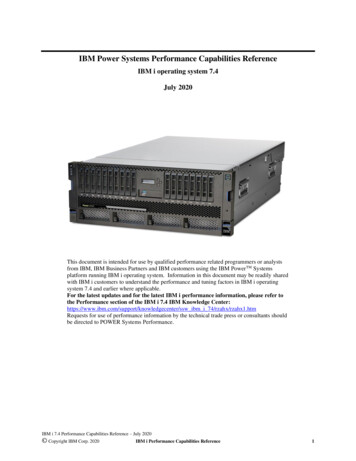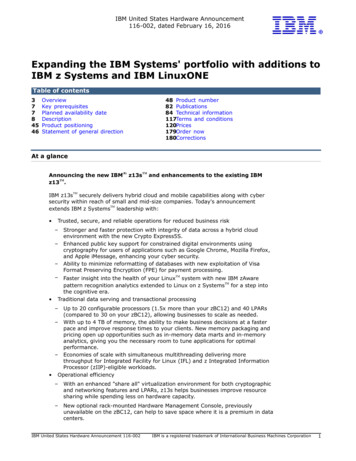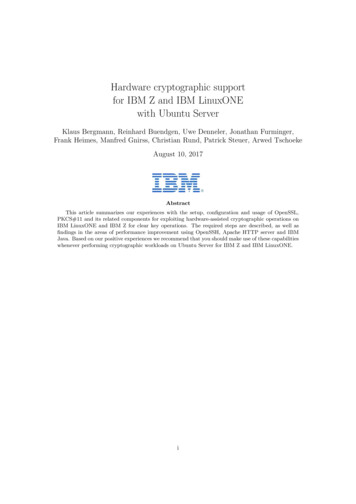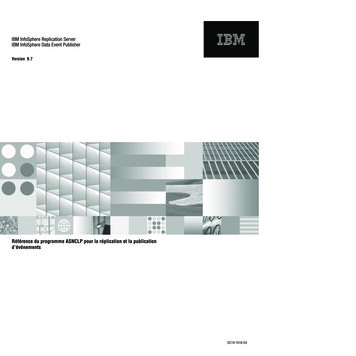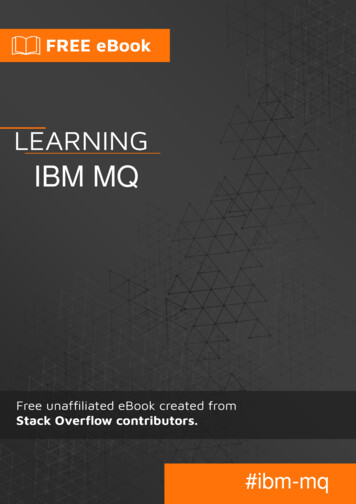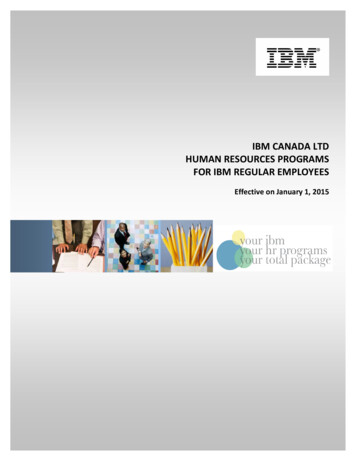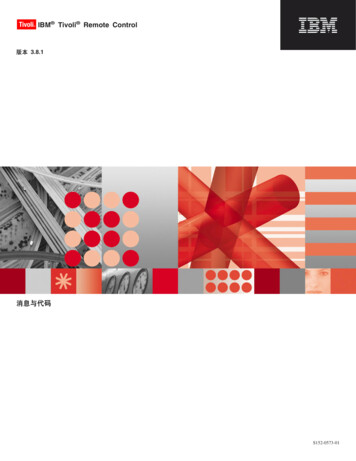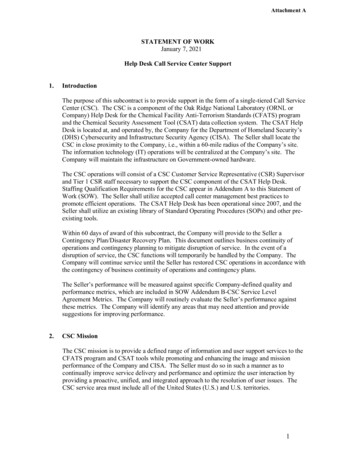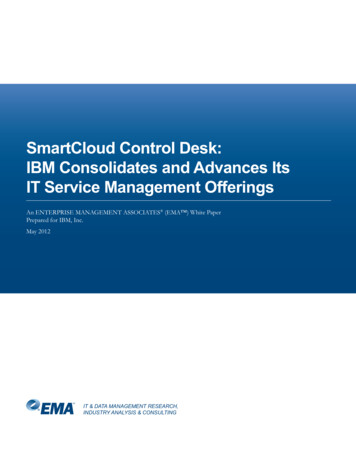
Transcription
SmartCloud Control Desk:IBM Consolidates and Advances ItsIT Service Management OfferingsAn ENTERPRISE MANAGEMENT ASSOCIATES (EMA ) White PaperPrepared for IBM, Inc.May 2012IT & DATA MANAGEMENT RESEARCH,INDUSTRY ANALYSIS & CONSULTING
SmartCloud Control Desk: IBM Consolidatesand Advances Its IT Service Management OfferingsTable of ContentsExecutive Summary.1Background.1IBM’s New Offering.2Marketing and Delivery.5EMA Perspective.6Conclusion.7About IBM.8 2012 Enterprise Management Associates, Inc. All Rights Reserved. www.enterprisemanagement.com
SmartCloud Control Desk: IBM Consolidatesand Advances Its IT Service Management OfferingsExecutive SummaryIn the spring of 2012, IBM launched a comprehensive re-thinking and refresh of its IT ServiceManagement (ITSM) offerings. The IT management products formerly known as Tivoli ServiceRequest Manager, IT Asset Management and Change Configuration Management Database have nowbeen combined into a single product, IBM SmartCloud Control Desk 7.5. The products span advancedsupport for IT and intelligent asset management, change and configuration management, servicerequest management and service catalog, along with Cloud delivery options and built-in support forautomation beyond traditional service desk workflow.BackgroundEMA is seeing the following set of current influences in the IT management tools market: Cloud computing, in its internal and external manifestations, driving IT towards more of a brokerrole in optimizing service choice and increasing expected velocity for provisioning, deploying,monitoring and retiring IT services. Pervasive computing. This encompasses: Smarter Physical Infrastructure , the IBM term for computing embedded throughout society:smart buildings, smart utilities, smart transportation, intelligent assets and so forth. The IT/OT convergence: Information Technology meeting Operations Technology. The consumerization of IT, driving IT towards a greater focus on consumer awareness andresponsiveness. Increasing change velocity resulting from increasing business requirements for faster time tovalue, being met by more agile and dynamic IT capabilities such as Cloud and DevOps.As the CIO moves from being a supplier of technical resources to becoming more of a Cloud servicebroker, IT management must bring together disparate resources into business oriented service views.An environment supported by a mix of Amazon, Salesforce.com, RackSpace, and other such servicesneeds an integrated service view as much as any traditional in-house IT organization.Lines are blurring as more businesses acquire converged assets, whichrequire bridging the divide between traditional “business” and “IT”issues. Asset management applies beyond the data center, into productionoperations (e.g., the shop floor, or the refinery). A locomotive with aPC in the cab is just another mobile endpoint – one weighing manytons! Today’s pervasively intelligent assets call for management in away that brings together the best of Operations Technology (OT) andInformation Technology (IT) approaches.A locomotive with a PCin the cab is just anothermobile endpoint – oneweighing many tons!Furthermore, no longer is an end user of IT management software necessarily in IT; they can be adoctor or a plant worker, or anyone within an organization that needs a service. Service catalogs haveexpanded from providing access to IT services, to front-ending processes for facilities, HR, and manyother functional areas in the business. And, as this self-service increases, consumerization is drivinghigher user experience expectations.1 2012 Enterprise Management Associates, Inc. All Rights Reserved. www.enterprisemanagement.comPage 1
SmartCloud Control Desk: IBM Consolidatesand Advances Its IT Service Management OfferingsThe demand for fast time to value across business operations and IT systems has led to the DevOpsand Agile movements and Cloud sourcing models. These responses in turn drive an increasing needto plan and schedule work across complex business and IT environments, and to further automatecapabilities such as change, configuration, incident, and problem management.Cloud is both a delivery option for ITSM tooling, and a challengeand catalyst for ITSM processes historically based on heavyweight,Cloud is both a deliveryin-house platforms and greater tolerance for implementation lead times.optionfor ITSM tooling, andTraditional approaches to ITSM are no longer given the luxury of multia challenge and catalystyear deployments just to achieve first-phase value. Self-service facilitiesfor ITSM processes.back-ended by robust change impact analysis are increasingly required ina world with no time for lengthy manual approval cycles. And while thereare now many flexible workflow-based SaaS-delivered ITSM offerings inthe IT management market, few have assimilated the policy-based run-book or IT process automationcapabilities essential to Cloud delivery, including the asset management (especially software licensemanagement) required to necessary to avoid costly audit failures.IBM has long had an offering in the ITSM marketplace. In 2006 IBM acquired MRO Software and itsMaximo product. This was distinguished by a general purpose workflow engine (an essential componentof any ITSM offering) and strong capabilities in non-IT asset management for industry. For example,railroads use Maximo to track locomotives and other rolling stock; utilities use it for detailed planningand maintenance of power distribution infrastructure; and hospitals use it for tracking the wide varietyof medical devices, from CAT scanners to MRI machines.IBM’s New OfferingIntroduced in March of 2012, the new SmartCloud Control Desk solution (version 7.5) bringscustomers a single, unified platform to drive control across the organization, balancing quick time tovalue and a variety of deployment options with a uniquely broad ability to manage service and assetprocesses across the entire scope of an enterprise (Figure 1).The release includes: Unifying the functional modules into one common look and feel Extensive usability improvements Support for common mobile scenarios – allowing for use on Blackberry, iOS, or Android devices Supporting full, bi-directional, automated integration of Assets and Configuration Items (CIs),including the ability to create one from the other and keep data in synch across them2 2012 Enterprise Management Associates, Inc. All Rights Reserved. www.enterprisemanagement.comPage 2
SmartCloud Control Desk: IBM Consolidatesand Advances Its IT Service Management OfferingsFigure 1. The evolution of Smartcloud Control DeskIBM has combined the following modules as part of one product and price point: IT Asset Management License Management Procurement Management Incident Management Problem Management Service Catalog and Request Management Change Management Configuration Management Release ManagementThis represents a unified and simplified suite offering enterprise-class functionality in IT management– “ITIL at the speed of cloud.” IBM also emphasizes the comprehensive nature of the unified suite’sability to control and coordinate a wide variety of IT and non-IT assets, whether internally or externallyhosted (Figure 2).3 2012 Enterprise Management Associates, Inc. All Rights Reserved. www.enterprisemanagement.comPage 3
SmartCloud Control Desk: IBM Consolidatesand Advances Its IT Service Management OfferingsFigure 2. SmartCloud Control Desk breadth of scopeAs IT and business processes become more and more intertwined and computing becomes morepervasive and heterogeneous, IBM believes that the integrated SmartCloud Control Desk providesgreat benefits in bringing together previously distinct management capabilities. Companies aremanaging assets, service request and changes across virtualized and non-virtualized environments,and the product thus features integrated asset processes where IT assets are managed along with othercomplex assets – a historic strength of this product line. (Note that full functionality in EnterpriseAsset Management, e.g., supporting non-IT capital assets, requires additional licensing.) Similarly,software license management data can be accessed from a service request or from a change request (doI have licenses/hardware in stock to satisfy that request?). No longer does a customer have to involvemultiple people or departments to provision licensing.Consumerization has been driving a higher standards for User eXperience (UX) of software platforms.Tivoli’s end users are changing. IBM has taken this challenge seriously and re-assigned senior Lotususability engineers to the SmartCloud Control Desk effort, resulting in improved, more intuitive, usercentric designs. Specific improvements include: Left-side navigation bar resulting in click reduction Portlets Decluttering of crowded interfaces Better user configurability (e.g., frequent tasks and My Assets)Increased support for mobile access is also included in the 7.5 release, including service request,incident, and change management.4 2012 Enterprise Management Associates, Inc. All Rights Reserved. www.enterprisemanagement.comPage 4
SmartCloud Control Desk: IBM Consolidatesand Advances Its IT Service Management OfferingsMarketing and DeliveryIBM is emphasizing four key aspects of the 7.5 release intended to “put a pause” in the market: The ability to manage IT and smart assets across the enterprise Pricing Usability Time to valueThere are three variations on the SmartCloud Control Desk product: SmartCloud Control Desk Entry Edition SmartCloud Control Desk SmartCloud Control Desk Service Provider Edition (providing support for multi-tenancy)The Entry Edition is restricted to simplified Incident, Problem, and Change modules, and is thereforeclearly aimed at smaller firms and emerging markets. The main SmartCloud Control Desk productprovides access to all modules at a single price per user.As one would expect from a company of IBM’s resources, a complete set of delivery options isavailable, from hosted to on-premise. Customers have the ability to move between delivery modelswithout losing functionality. IBM is also making use of virtual appliances as a distinct deliveryoption. Channel partners may run their own multi-tenant instances to support multiple clients on oneintegrated platform.Tivoli Direct Sales(on-premise or“private” SaaS)Business PartnerSales (on-premise orSaaS)Traditional InstallTypical SW saleTypical BP saleVM image installEasy installation option/ “Behind the firewallSaaS”Easy installation option /Business Partner hostedSaaSHosted on IBM Cloud(SaaS)IBM SmartCloud ControlDesk - SaaSThe pricing model has also changed to per-user, “all you can eat” in terms of access to all functionalmodules (except for the Entry Edition). This will reduce the effort a customer must spend in managingcustomer licenses. Prices are aggressive to capture customers that want a better ROI in terms ofpricing and having a single, highly-integrated product and maintenance stream.IBM’s current product roadmap (subject as always to change) includes Interfaces into SAP Solutions Manager Further improvements for deployability and ease-of-use Higher levels of automation Enhanced reporting and analytics capabilities5 2012 Enterprise Management Associates, Inc. All Rights Reserved. www.enterprisemanagement.comPage 5
SmartCloud Control Desk: IBM Consolidatesand Advances Its IT Service Management OfferingsEMA PerspectiveAs computing becomes pervasive throughout business operations and assets, computing practices arealso becoming pervasive. While some would like computing to gracefully disappear into a backgroundutility service, EMA believes that IT is fundamentally different from electricity. IT asset and servicemanagement practices such as incident, change, and configuration management will not fade away;instead, they will become much more of a daily concern for many participants in an enterprise.Gains made through automating core IT into Cloud architectures may well be offset by new concernsin managing the fabric of pervasively embedded computing.IBM has long had a comprehensive product set for end-to-end IT management. Tivoli especially hashad historic strengths in monitoring and real-time service management (via the Netcool product). Morebroadly, IBM also has an industry-leading portfolio of Application Lifecycle Management tools in theRational line, as well as some of the most widely used middleware products in the Websphere line.These platforms have been accompanied by deep and proven vertical extensions, an advantage uniqueto IBM. Verticals like financial services, transportation, and healthcare all have IBM solutions specificto their problem domain.Maximo’s depth in non-IT markets is a substantial advantage forSmartCloud Control Desk. As can be seen at the annual IBM Pulseconference, there is a rich ecosystem of solutions providers and vendorsskilled in implementing solutions on the core Maximo framework.This translates to a deep pool of expertise that can be leveraged acrossdomains; EMA interviewed vendors previously focused on the non-ITEnterprise Asset Management side of Maximo that have started todevelop extensions for IT management. And strategically, this ecosystemgives IBM the reach and execution ability to realize its ambitious goals.IT asset and servicemanagement practices suchas incident, change, andconfiguration managementwill not fade away; instead,they will become muchmore of a daily concernfor many participantsin an enterprise.Many of IBM’s products were acquired, not organically grown, andintegrating IT management products is complex. Much progress hasbeen made, e.g., through employing the Open Services for LifecycleCollaboration (OSLC) standard to tie the Rational and Tivoli product linestogether across the DevOps value stream of developing and deployingsoftware. EMA believes that DevOps is a genuinely important trend in current IT management andcommends IBM’s clear investments and thought leadership in this area.These kinds of silo-crossing initiatives are now being called on to support more strategic priorities. Ascomputing becomes pervasive throughout industry, traditional functional boundaries are dissolving. IBMhas therefore been well advised to invest in usability, especially given the influence of consumerizationand competition from a variety of SaaS ITSM providers such as ServiceNow, CA Nimsoft, and BMCRemedyForce. These next-generation providers have clearly raised the user experience bar. IBM hasbeen making substantial strides in terms of usability and integration, and with SmartCloud ControlDesk 7.5 IBM should now be able to claim a leading position in time to value.IBM has continued to invest in the Tivoli Process Automation (TPAE) platform as a basis for itsIT management portfolio. Where some competitors have acquired multiple workflow engines forprovisioning, runbook automation, and ITSM process support, SmartCloud Control Desk’s TPAE-basedintegration of IT Process Automation (a.k.a. runbook automation) with workflow is a differentiator.6 2012 Enterprise Management Associates, Inc. All Rights Reserved. www.enterprisemanagement.comPage 6
SmartCloud Control Desk: IBM Consolidatesand Advances Its IT Service Management OfferingsIt is rare for IBM to compete on price, but between the commoditization of the ITSM market and thechallenges they have encountered there, it seems a reasonable strategy. If IBM is aggressive enough,this may present a great opportunity for customers, as the actual functional capabilities of the platformare broad and suitable for the largest enterprises.EMA predicts that IBM will leverage its vertical strategies to boost SmartCloud Control Desk innon-traditional ways, as business managers have increasing operational responsibilities for informationtechnology. Rather than selling SmartCloud Control Desk to the CIO, IBM is well positioned to sell itto line managers directly in business units, on the basis of its strengths in non-IT asset managementand IBM’s robust sales channels in those verticals. Furthermore, IBM Global Technical Services usesMaximo as the common platform for large outsourced engagements, a built-in stream of use andrevenue for the product.In looking to the future, IBM has some work ahead of it in maturing its “Business Management of IT”strategy. IT finance and portfolio management, project management, demand management, enterprisearchitecture, and related areas all have coverage in IBM products, but there remains much fragmentationand some emerging overlaps. A full, end-to-end DevOps approach challenges traditional boundaries.For example, Maximo has an increasingly robust capability in change scheduling, even including aGantt view one might also see in a project management tool. Similarly, IBM has made progress withKanban on the Rational side, but this fast-growing, disruptive approach to managing the flow of ITwork is equally applicable to operations teams. Kanban for Maximo? EMA applauds IBM’s innovationsin these areas, as demand and execution management are large challenges for IT management, yetfurther decisions as to the relative scope of the Rational versus Tivoli lines in these areas seem needful.However, it’s clear that IBM is aware of these challenges and is continuing to develop innovativeapproaches for bridging these worlds. As a more integrated IT management future comes closer, IBMis well positioned in terms of platforms, technical thought leadership, and vertical expertise to play acommanding role.ConclusionIBM has some of the industry’s deepest roots in IT service management. The IBM “yellow books”(A Management System for the Information Business) were an important precursor to ITIL in the 1980s. It istherefore encouraging to see IBM’s ongoing commitment to improving the maturity and automationof IT management, in the context of industry-transforming trends such as Cloud, consumerization,pervasive computing, and DevOps. And as IT transforms and embeds throughout business strategiesand operations, the essential core of IT management practices will similarly need to transform, whileretaining the value propositions of ensuring agile and reliable computing.The Maximo acquisition was clearly strategic and IBM has demonstratedsubstantial commitment to expanding upon the Maximo-basedcapabilities in supporting management practices across both IT andbusiness vertical domains. While it has been a “long game” for IBM,the company is well positioned to execute over such time frames. At theproposed price points, the newly revamped product may indeed becomea very disruptive offering to the market, both competitively and in termsof driving the industry as a whole towards higher levels of maturity.7 2012 Enterprise Management Associates, Inc. All Rights Reserved. www.enterprisemanagement.comIBM has demonstratedsubstantial commitmentto ex
SmartCloud Control Desk: IBM Consolidates and Advances Its IT Service Management Offerings Executive Summary In the spring of 2012, IBM launched a comprehensive re-thinking and refresh of its IT Service Management (ITSM) offerings. Th
